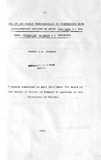| dc.description.abstract | Field trials were designed to determine the
effect of various weed control methods in maize. (Zea
mays L.) and bean (Phaseolus vulgaris L.) intercrop.
Pendimethalin herbicide was applied at three rates i.e.
1.5, 1.0 and 0.5 kg a.i./ha on maize and bean intercrop,
to determine the degree of weed control and herbicide
injury on the, crops. The two lower rates were combined
with one supplementary weeding each, to determine weed
control, reduction on weeding time and cost. Manual
weed control methods were included to help compare the
net monetary benefit of each weed control method. Other
cropping systems namely sole maize and sole beans
were studied to determine the effect of intercropping
on weed control and crop yields.
According to this study, intercropping maize
and beans showed no consistent effect on weed
suppression, although it yielded the lowest weed dry
matter of the three cropping systems. Intercropping
maize and beans suppressed bean yield by 486.3 kg/ha
in the short rains and 735.7 kg/ha in the long rains,
but in terms of monetary benefit, was the prefered
cropping system.
There were marked differ2nces between weed
control treatments. Application of pendimethalin
(viii)
at 1.5 kg a.i./ha caused deformation and stunted
growth on beans, often in localised spots. Both low
rates, 0.5 kg a.i./ha and 1.0 kg a.i./ha, did not
cause any herbicide injury on beans and did not
control any of the prevalent weed species. Combined
with one supplementary weeding each, however, they
effected better weed control than pendimethalin alone
at 1.5 kg a.i./ha.
The two low rates; 0.5 kg a.i./ha and 1.0 kg/
ha combined with supplementary weeding reduced weeding
time by 20.1, 21.3 man-days/ha in the short rains and
11.5, 15.2 man-days/ha in the long rains, respectively
and achieved about the same degree of weed control :as
two hand weedings. They further reduced cost of weed
control by 15.2, 8.9 US$/ha in the short rains and 9.0,
1.3 US$/ha in the long rains compared to two hand
weedings, but raised cost by 3.4, 9.7 US$/ha in the
short rains and 8.4, 12.2 US$/ha in the long rains
compared to chemical control with pendimethalin at 1.5
kg a.i./ha. Results were, however, not consistent in
the two seasons,' suggesting a seasonal influence,
particularly amount of rainfall received soon after
application of herbicide.
The use of low dosages of herbicide plus
(ix)
supplementary weeding compared vary favourably with
two hand weedings, the cultural method of weed
control, in net benefit. They both gave higher
monetary benefit than both use of herbicide alone
at normal rate i.e. 1.5 kg a.i./ha and a single hand
weeding. Of the two low rates, 0.5 kg a.i./ha plus a
supplementary weeding was to be prefered as it gave a
higher net benefit.
The use of low dosages of herbicide combined
with a supplementary hand weeding in this study, as
in other studies, provides an alternative method of
weed control. It reduces labour requirement and cost
of weed control, at the same time, gives a comparable
net income to the cultural ITethod of weed control. | en |

